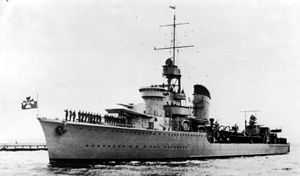J. Samuel White
| Private company | |
| Industry | Shipbuilding |
| Defunct | 1981 |
| Headquarters | Cowes, Isle of Wight |
J. Samuel White was a British shipbuilding firm based in East Cowes, taking its name from John Samuel White (1838–1915).
It came to prominence during the Victorian era. During the 20th century it specialised in building destroyers for both the Royal Navy and export customers.
History
The family had a long tradition of shipbuilding in Kent, with James White constructing the cutter Lapwing for the Royal Navy at Broadstairs in 1763–1764, as well as fast vessels for the Revenue services and fishing smacks, and even a number of West Indiamen. At least three generations of the White family business undertook shipbuilding before Thomas White, (1773–1859) the grandfather of John Samuel White, moved from Broadstairs, to East Cowes on the northern coast of the Isle of Wight in 1802, where he acquired the shipbuilding site on the east bank of the River Medina where there was already more than a century of shipbuilding tradition. In the closing years of the Napoleonic War he began work on what would become the 'Thetis' Yard across the river on the West bank on the 'salterns' and marsh between the Medina and Arctic roads. It opened officially on 1 October 1815. White subsequently rebuilt the east bank site which in 1825 became the Falcon Yard.



Records indicate that by the 1850s White's docks with its steam sawmills and engine shops, and the mast and block shops, provided work for around 500 craftsmen. J Samuel White expanded still further in 1899. It rapidly became a world leader in the design and construction of small- to medium-sized naval and merchant ships, and also built numerous smaller craft, including more than 130 lifeboats for the RNLI, more than any other builder.
With the regular construction of turbines, boilers, steam and diesel engines, the East Cowes site became an engineering works. The general decline of shipbuilding in Britain led to the launch of the last vessel for the Royal Navy in 1963 and the closure of the shipyard. In 1981 the company finally ceased trading.
"Sammy" White has built well over two thousand vessels at their various shipyards at East Cowes between 1803 and their eventual closure in 1963.
Paul Hyland describes how White had grown during the succeeding century:
| “ | In May 1942 the Polish destroyer 'Blyskawica' was being urgently refitted at J Samuel White where it had been launched. On the night of 4 May, the Luftwaffe let fly with 200 tons of bombs, a wave of incendiaries followed by high explosives. The Blyskawica left her moorings, dropped anchor outside the harbour, and retaliated all night with such vehemence that her guns had to be doused with water, and more ammunition had to be ferried across from Portsmouth but for her, the 800 casualties and thousands of damaged buildings, including 100,000 square feet (10,000 m2) of wreckage at Whites, would have been far worse. | ” |
Sir Barnes Wallis, later famous as an aeronautical engineer, worked as a draughtsman for the company at the start of his career, before moving to Vickers to design airships.
Two White-built destroyers were preserved – ORP Błyskawica (the oldest preserved destroyer in the world) and HMS Cavalier (the only wartime destroyer preserved in the UK).
Aircraft production
Between 1912 and 1916 the company had an aviation department that built a number of seaplanes using the name Wight Aircraft:
- Wight Pusher Seaplane
- Wight Twin
- Wight Seaplane
- Wight Baby
- Wight Bomber
- Wight Converted Seaplane
- AD Seaplane Type 1000
In 1913 the company produced a flying boat which was displayed at the London Air Show at Olympia in 1913.[1] The company also manufactured 110 Short Type 184 aircraft designed by Short Brothers.
Through 1916-1917 the company developed the Wight Quadruplane prototype fighter. This aircraft was tested at Martlesham Heath from 1917, and was written off in 1918.[2]
See also
References
Publications
- Colledge, J. J.; Warlow, Ben (2006) [1969]. Ships of the Royal Navy: The Complete Record of all Fighting Ships of the Royal Navy (Rev. ed.). London: Chatham Publishing. ISBN 978-1-86176-281-8. OCLC 67375475.
- David L. Williams, White's of Cowes. Silver Link Publishing, 1993. ISBN 1-85794-011-3.
External links
| Wikimedia Commons has media related to J. Samuel White. |
- Pictures of some of J. Samuel White's ships
- Naval Ships of J. Samuel White
- Photos of J. Samuel White's fitting out crane
| ||||||